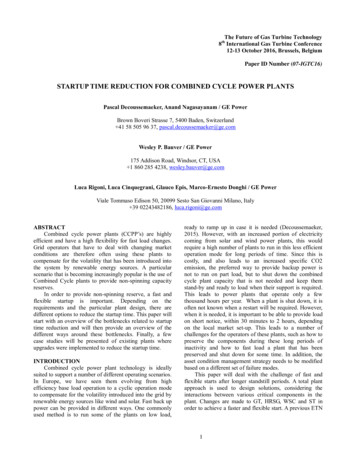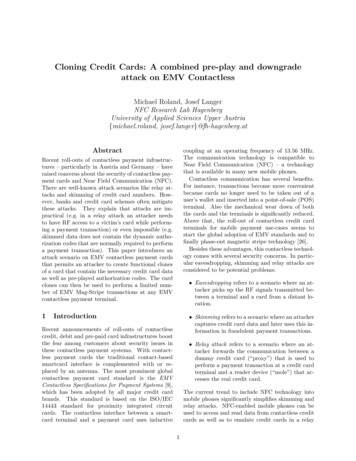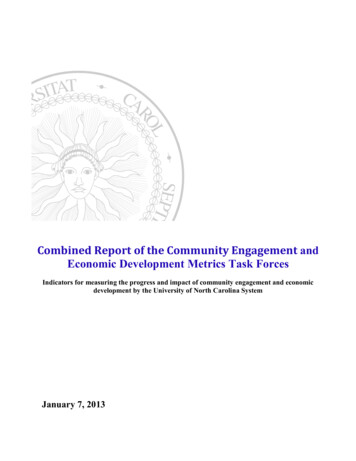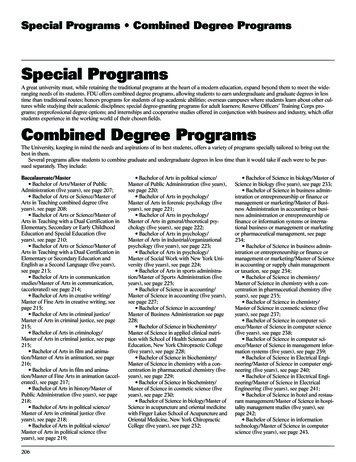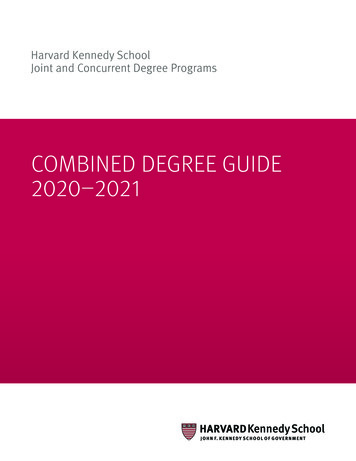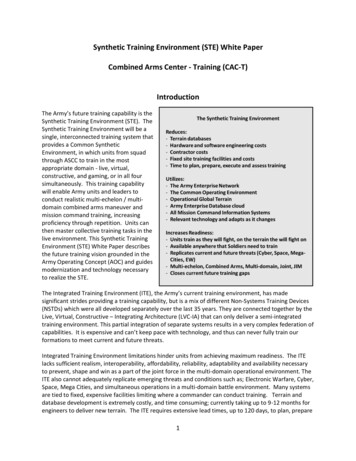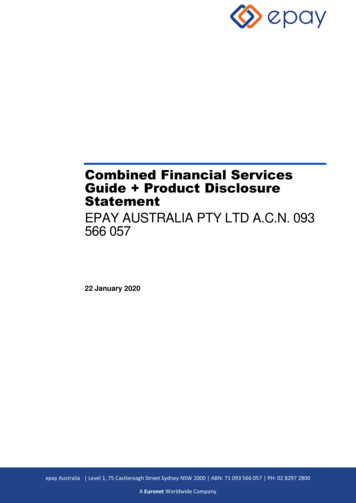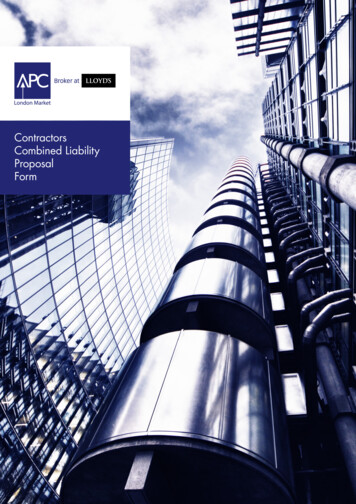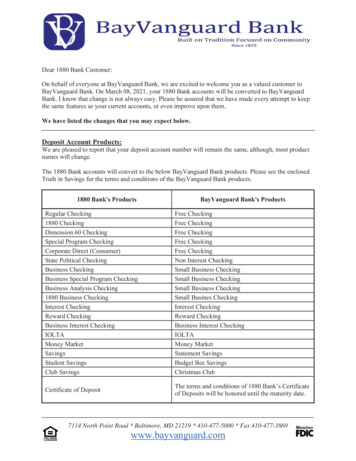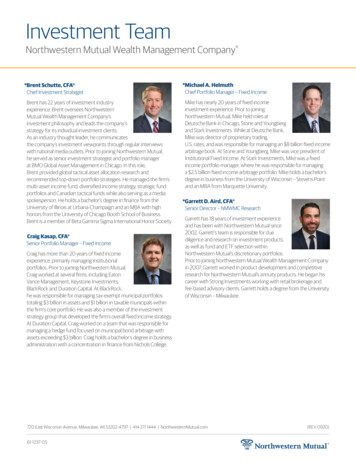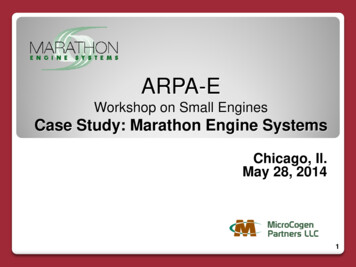
Transcription
ARPA-EWorkshop on Small EnginesCase Study: Marathon Engine SystemsChicago, Il.May 28, 20141
Background and History 1984– GRI approached Battelle Columbusto design an engine driven NG heat pump.1988—Triathlon prototypes were startedw/ potential suppliers: York Intl, Briggs &Stratton, Honeywell, Copeland.Key Marathon engine specifications : 4,000 hr oil change interval (11 litersump. Equivalent to 160,000 miles) Ten year life or 40,000 hr. (Equivalent to1.6 million miles). 7.5 hp, 272cc, 12.8/1 compression. 1200-3600 rpm. Single cyl. No belts. York Intl. marketed and sold units from1992 to 1997. About 3,000 systems inplace. Warranty issues caused demise.1998--HyPro, Inc. bought the engine andstarted MES for remote power application.2001--Teledyne Brown sold Minotaur forcathodic protection. MES bought that also.2
Evolution of ecopower 1998- Call to Briggs fromecopower Energy Solutions AG,Swiss venture backed companywith a microCHP--new product in need of a long life engine.mCHP starting in Europe.Two engines were sold fortesting. Worked well.150 sold in Europe– but.2002– ecopower AG--bankrupt,MES bought world rights andVaillant (German boiler Co.)bought European rights-usingthe Marathon engine--until2011– now use German engine.MES tried to market theecopower in US but had no ideaof the barriers.3
ecopower MicrocogenAppliance Electrical output 2.2 - 4.4kWe/hrmodulating Heat output is 20,000 -- 47,000BTU/hr Maintenance interval: 4,000 hours–Oil, filters, spark plug Engine life – 40,000 hours.4
“Energy cannot be created or destroyed.Only converted from one form to another”First Law of Thermodynamics5
Private Residence –Dover, Massachusetts 9,000 sq.ft.28,000 gallon pool @ 85 F(Grandkids)Full in-floor radiant heatingsystem in the houseGeothermal system asbackup.In 20 months of ecopoweruse -- generated 40 Mwh ofelectricity @ 0.23/kWhsavings of 9,0006
Multifamily ApartmentDomestic hot water for a 56Unit, LEED Platinumapartment building .Bronx, NY Two units: 9.4kWe and78,000Btu/hr total.Installed August 2009Can generate: 6.5 Mwh/moCurrent electric rate is 0.25/kwhIn the first 12 months –69Mwh.Savings of 17,000 peryear in electrical costs.7
Commercial HotWater Applications LEED Platinum, 125 unit apt.in NYC.3,000 gal buffer tankUnits generate 9-12,000kWhper monthSavings of up to 2400/mo.in electric costs.Discounted gasYMCA swimming poolcomplex in WisconsinNew install – awaiting data.8
Markets for mCHPCommercial Market isstronger and showspromise Multifamily apartments Nursing Homes/ Assist.Living Health Clubs School District SwimPools Restaurants/ Truck Stops Medium Size motel Hydroponic farms Greenhouses Laundries Car Washes Large Building Reheat Larger Homes w/ pools.9
Current MicroCHP ManufacturersMarketing in the US Marathon Engine Systems. manufacturesand marketed the ecopower 4.7 kW(e) ICE Yanmar– Two products in the market – a10kWe ICE unit and now a 5kWe . Yanmar ClearEdgeFreeWatt ClearEdge– Fuel Cell (5kWe) and is on hold.Recently filed for bankruptcy.Climate Energy/ Freewatt– Marketed by ECRbut now in a reorganization. Mostapplications in the Northeast with 300 installs. 1.2 kWe ICE (Honda)Capstone Turbine- a family of six units30kWe to 1000kW. Sales worldwide.EC Power– Danish ICE based system. Foursizes: 6, 9, 15, 20kWe. In Canada now,starting a US office 1Q2014.Total Sales: Worldwide* -- 212,000 EC PowerCapstoneJapan ---155,000 unitsEurope--- 45,000 unitsRest of the World --- 12,000US 600 units( * Source: Delta-ee)10
New Entrants in the Market QnergyM-CogenMicrogen Fuel CellsNRG /DekaQnergy – an Israeli company has developed a7.5kWe Stirling engine (FPSE) for use in themCHP market as well as remote power. Willenter in 2015.Microgen- a consortia of companies havetaken the 1kWe Stirling engine developed byMicrogen and a number of them areconsidering the NA market. In addition NRGEnergy and DEKA are set to market a 1015kWe (6kWe)? Stirling.Fuel Cells– a number of small fuel cell productmfgs (1-3kWe) are looking seriously at the NAresidential market.Thermal Acoustic/Electric Generators are indevelopment and could enter in the next twoyears. 3kWeM-Cogen--- Houston based company that hasdeveloped a Trigen system using an ICE andan adsorption cooling system. Heat, powerand cooling. 6kW(e) and 5 tons of cooling.11
Advantages and Disadvantages of microCHP TechnologiesICEUsage inthe WorldMajorAdvantageMajor 8%ProventechnologyNeeds longlife engine20-30%85-92%High heatFuelAgnosticDifficult toManufact.10-20%Low 80’sNow 66%*Stirling18%Now 6%*OrganicRankine 2%Low CostHi HeatPoor ElectEfficiency 10%90 %Fuel Cell2%77-80%Now 25%*Hi PriceReformer?30-35%PEMLowEmissionsMicroTurbine 1%Hi heat outLong lifeMulti- fuelHi pressgas. HipriceMid 20’s80-92%Delta ee *Change because of 23,000 FC sales in 2012 in Japan
Future for MicroCHP*Barriers to EntryDrivers: Energy CostsSystem CostsAging GridEnergy AwarenessNew Entrants and CompetitionOpportunities Large MarketProven/positive track recordSpark Spread is very favorable. Clean Emissions – significantly less CO2 NOx and SO2. Carbon Credits (?)Good Niches– Hot water apps. High EfficiencyLeasing is becoming viableBackup power can be an option.Smart Grid / Demand ResponseMultiplexed for larger needs. Large Capex for install– High costsbecause of being an emergingtechnology. Can be 3k-8,000/kW.Utility Reluctance. Slow to changeSales Channel-- can be difficult becauseof understanding new technology.Education – of all parties-- customer,dealer, legislators, utilitiesStigma-- because of not beingrenewable.Legislation-- is slow to change andinconsistent. Fifty sets of rules.Heat Driven therefore limiting to colderclimesCooling technology – some exist but areexpensive and not practical.* “I hate making predictions–especially if it’s about the future “Lawrence Peter Berra13
HOELVECHS*Concept Schematic Long life 5kW enginegeneratorCapable of running 4,000hours betweenmaintenance needs.Natural gas or propanefueled.Electric vehicle chargingcapable –Level 1 & 2.Therefore, no grid strainBackup power capable forgrid outages. May have abattery complement.(Optional)Is Smart Grid compatible,the 5kW would bedispatchable power andcontrolled by the utility.Ultimately will be vehicle togrid (V2G) capable*Home Electric Vehicle ChargingSystem14
Mike Cockingon behalf ofMarathon Engine Systemsmicrocogen99@gmail.com262.353.626315
Key Marathon engine specifications : 4,000 hr oil change interval (11 liter sump. Equivalent to 160,000 miles) Ten year life or 40,000 hr. (Equivalent to 1.6 million miles). 7.5 hp, 272cc, 12.8/1 compression. 1200-3600 rpm. Single cyl. No belts. York Intl. marketed and sold units from 1992 to 1997. About 3,000 systems in place.

